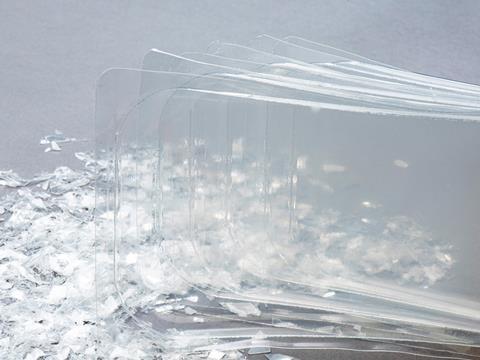
A collaborative project involving BASF, Krones, SÜDPACK, and TOMRA claims to have demonstrated that it is possible to separate PET/PE multi-layer packaging into its individual components and return them to the materials cycle as raw materials.
During the first industrial trial conducted at a Krones pilot plant in Flensburg, the partners say that they were able to completely separate as much as 69% of the PET/PE components and partially separate another twelve percent. This approach uses existing infrastructure to recycle the multi-layer packaging.
The first phase of the project was initiated in early 2021 when TOMRA conducted the first sorting trials with PET/PE trays. These trays had been manufactured by SÜDPACK using a “debonding adhesive” developed by BASF.
“Our contribution to the collaboration project was our long-standing expertise in lamination. Using our expert know-how in water-based lamination, we were able to develop multi-layer films that can be separated by caustic hot washing,” says Carolin Grimbacher, Managing Partner at SÜDPACK, who is also responsible for R&D.
To close the materials cycle, the recyclable multi-layer films first have to be sorted out of the waste stream. The main determinant of success for this step was the ability of the AUTOSORTTM technology of TOMRA to separate the recyclable PET/PE trays from non-recyclable trays.
“Our NIR technology made this possible because it is able to detect the multi-layer PET trays containing the adhesive of BASF. With this it’s possible to sort the trays out of the waste stream and add them to the recyclables,” David Rüßmann, Manager Special Projects, explains.
Krones, a company that, among other things, develops plastics recycling systems, joined the project team in July 2022. At one of the company’s pilot plants, trials were carried out to test whether it’s possible to separate laminated PET/PE films to their single layers in an industrial scale.
The companies report that a standard hot washing process commonly used for PET recycling was applied successfully and as a result, the separated PET and PE can be re-used as monomaterials. “At our facility, we proved that the delamination of multi-layer films works. However, the separation of the films can still be improved by optimizing individual process parameters as well as, for example, the particle size of the flakes,” Thore Lucks, Head of Techology Recycling Solutions at Krones, explains.
The process of separating the PET and PE components of the film is based on adhesives that were specifically developed for this purpose. These adhesives are used during the lamination of multi-layer films to join different functional materials.
BASF says that the lamination adhesive must have the best possible adhesive strength when required, but still makes it possible to easily separate the two films when it comes time to recycle. “Our water-based Epotal adhesives already yielded very good results when separating multi-layer packaging in the laboratory. We consider it a huge success that we were able to completely separate 69% of the packaging during our very first industrial trial. We are confident that we will be able to further increase this figure by optimizing our debonding adhesive,” Kresimir Cule, Commercial Marketing Industrial Adhesives, BASF SE, states.
The project is still ongoing. By adjusting various parameters of the recycling process and by further developing the lamination adhesive used, the project partners see additional opportunities for improving the recycling rate for plastics.
The quality of the recycled materials is a major focus. The aim is to be able to reuse the PET for the manufacture of food packaging, while the PE fraction will be used as a raw material to make new packaging for the non-food industry. Studies on this will reportedly be carried out shortly.
If you liked this article, you might also enjoy:
McKinsey on whether or not on-pack sustainability claims affect consumer spending
A deep dive into the most important packaging sustainability trends and solutions












No comments yet